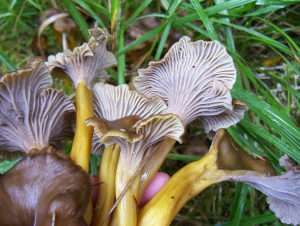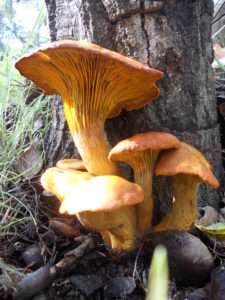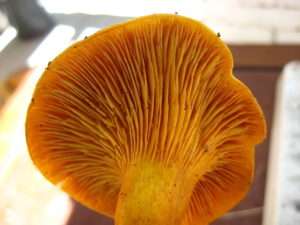Click here to learn more about the How to Identify article series.
Name: Yellowfoot Mushroom (Craterellus tubaeformis, previously Cantharellus tubaeformis)
Range and typical habitat(s): Temperate/cold regions of North America, Europe, portions of the Himalayas. This species is mycorrhizal with several conifer species (including but not limited to Tsuga heterophylla and Pseudotsua menziesii) and so is primarily found in conifer forests and nearby boggy areas. The mycelium grows on both soil and rotting wood, and fruiting bodies (mushrooms) may be seen popping out of the surface of the substrate.

Distinguishing physical characteristics (size, colors, overall shapes, detail shapes): The cap of this mushroom rarely exceeds two inches across, and usually isn’t much more than three and a half inches tall. Looking much like its Cantharellus cousins, this mushroom has a funnel or trumpet shape when mature; the edge of the cap is often wavy, and the center concave even when young. Color is the main way to distinguish this mushroom, as the upper side of the cap is brown or yellowish brown, while the stipe (stem) is a comparatively bright yellow. The spore print is white to buff. The stipe is hollow in older specimens while the cap is solid; the stipe may also have a grooved texture on the outside. No veil, ring/annulus, or volva/cup apparent.
The yellowfoot is sometimes known as the winter chanterelle because it can often be found well into January and February. Depending on the area, yellowfoot mushrooms may be found starting in late summer and going until early spring.
The cap has false gills that may extend a little way down the stipe and are usually a pale yellow, though they may be grayish in some specimens. Unlike true gills, which are very closely spaced and thin like pages in a book, false gills are thicker, chunkier, and more widely spaced. I liken them to looking as though they were carved out of wax or wood. The false gills may fork as they get closer to the edge of the cap.

Other organisms it could be confused with and how to tell the difference: Yellowfoot looks a lot like golden/yellow Cantharellus chanterelles; the main difference is the darker-colored cap and sometimes hollow stipe in yellowfoot. Chanterelles may grow in soil, and favor conifers as yellowfoot mushrooms do. Yellowfoot and the chanterelles are all edible.
On the other hand, beware of the jack o’ lantern mushrooms (Omphalotus olearis, Omphalotus olivascens, and Omphalotus illudens)! It is another funnel-shaped mushroom that is orange in color, though the upper side of the cap may be a darker orange that looks brownish in some lights, with lighter-colored gills underneath; O. olivascens‘ cap may also have a greenish tint. Jack o’ lanterns have true gills instead of false. Like yellowfoot they may grow on rotting wood, though they do not grow on soil. Jack o’ lanterns are also bioluminescent and may glow at night.




Anything else worth mentioning? Yellowfoot mushrooms are considered edible by most sources. However, the Peterson Field Guide to Mushrooms of North America, second edition, lists this species as “gray-gill chanterelle”, and describes it as not edible because “some mild but uncomfortable poisonings are reported from species in this group” (p. 206). “Group” is not specified but might refer to genus, or all populations of this species; I’m not sure. I couldn’t find any other sources, either books or websites, that corroborated the claim of toxicity (if you find any, feel free to let me know!) Chanterelles (Craterellus and Cantharellus) in general may make a small number of people sick just as other edible wild mushrooms can, but this does not make them widely considered poisonous and may be an effect of individual digestive sensitivities. As always, always be 100% sure you know exactly what mushroom you have and that it is definitely safely edible BEFORE you eat it, and always cook and eat a SMALL amount when trying a new edible mushroom for the first time. When in doubt, throw it out!
Further reading:
Forager Chef: Foraging and Cooking Yellowfoot Mushrooms
Mushroom Appreciation: Yellowfoot Chanterelle
KPMS: Yellowfoot, Winter Chanterelle
Mushroom Stalkers: Where to find Yellow-foot Chanterelles?
Did you enjoy this post? Consider taking one of my online foraging and natural history classes, checking out my other articles, or picking up a paperback or ebook I’ve written! You can even buy me a coffee here!
